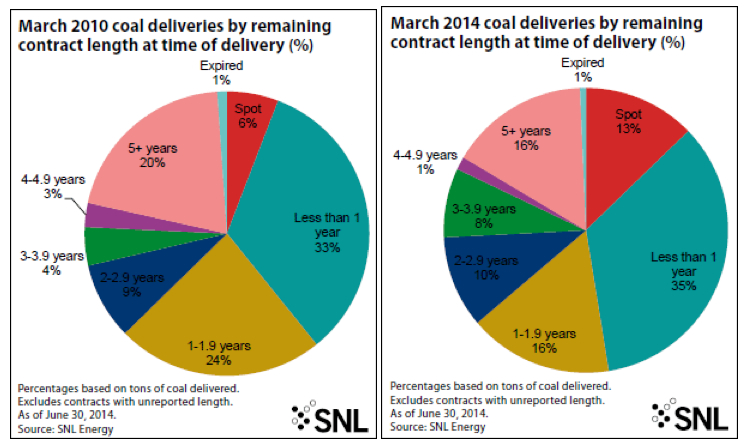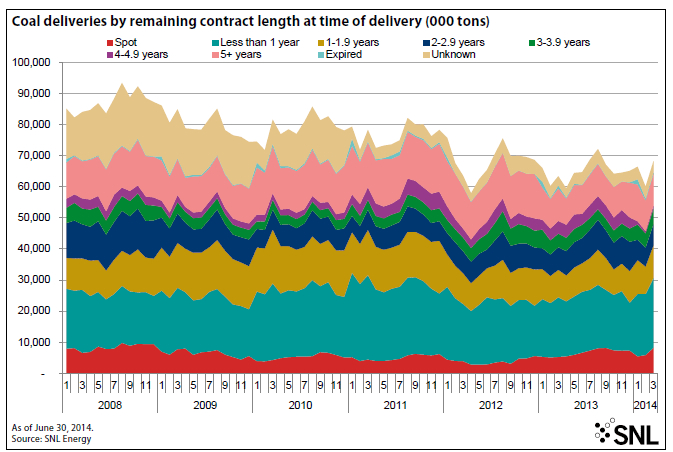For US coal industry, volatility ‘a new normal’

The U.S. coal industry is facing an even more uncertain future as the impacts from weaker demand and environmental regulations are creating more contractual volatility from the utilities to the railroads.
In its most recent Form 10-K, Alpha Natural Resources Inc., a major player in Central Appalachia coal markets, warned investors that the increasing difficulty of locking in long-term contracts could reduce the company’s protection from short-term coal price volatility. Alpha said that in 2013, about 45% of its steam coal was delivered through long-term coal contracts.
“In large part as a result of increasing and frequently changing regulation … and natural gas pricing, electric power generators are increasingly less willing to enter into long-term coal supply contracts, instead purchasing higher percentages of coal under short-term supply contracts,” Alpha wrote in its filing. “This industry shift away from long-term supply contracts could adversely affect us and the level of our revenues.”
Arch Coal Inc. expresses a similar concern in a section of its Form 10-K.
“Changes in the coal industry may cause some of our customers not to renew, extend or enter into new long-term coal supply agreements with us or to enter into agreements to purchase fewer tons of coal than in the past or on different terms or prices,” the filing states. “In addition, uncertainty caused by federal and state regulations, including the Clean Air Act, could deter our customers from entering into long-term coal supply agreements.”
According to an SNL Energy analysis of fuel contract data from the U.S. Energy Information Administration supplied on Form EIA-923, the prized long-term coal contract appears to have become more elusive in the past four years. In March, 16% of coal delivered came from contracts with remaining terms beyond five years, down from 20% in the same period in 2010.
In increasingly competitive markets, a long-term coal contract can offer price, volume and earnings stability that allows companies to make long-term planning decisions regarding their mines.
“Obviously, any time you’re producing any product, having the benefit of a long-term contract creates stability in production, employment, available resources to produce the product, etc.,” Bill Bissett, president of the Kentucky Coal Association, told SNL Energy.
Peabody Energy Corp., a company that heavily utilizes long-term contracts, has seen some of its contracted position contract. According to its most recent Form 10-K, the company has seen its worldwide sales under long-term coal supply agreements shrink from 91% in 2011 to 80% by 2013.
Vic Svec, senior vice president of global investor and corporate relations at Peabody, told SNL Energy that contracts have become shorter, but the response to depleting inventories would vary based on whether the utility is a co-op, a regulated utility or an unregulated utility.
“They certainly could turn a little longer term in nature for the reasons like we saw this past winter, when inventories got low,” Svec said. “Ultimately, it will be up to the generators — whose job is to provide reliable and low-cost electricity — to determine the right duration and decide this is how much they stay hedged. That will be very individualized.”
Many utilities are turning to the more volatile spot market, which according to the SNL Energy analysis, accounted for 13% of the coal delivered to utilities in March, compared to 6% four years prior. Southern Co., for example, issued four public solicitations for coal in 2014 by early April. Nearly all of the coal was for 2014 delivery.
Bissett said the amount of coal under long-term contracts varies by company, with each company tailoring its contracting to exploit the various advantages and disadvantages of long-term contracts. He said the spot market can offer advantages to an “ailing and economically vulnerable” region like eastern Kentucky where there is coal available, but end users are not currently available.
Central Appalachia, where geological conditions and other factors tend to force higher prices compared to other coal basins, has a particularly difficult time with locking utilities into long-term coal supply contracts. Bill Davison, vice president of thermal coal sales at Alpha, recently told SNL Energy that “contracts longer than a year are almost exclusively in the west, in the Powder River Basin.”
Additionally, coal companies are often tied to contracts subject to price reopeners that allow utilities to renegotiate the pricing on long-term contracts to reflect lower market prices. Long-term contracts also can prevent coal companies from capitalizing on opportunities when market conditions do turn around.
“Any adjustment or renegotiation leading to a significantly lower contract price could result in decreased revenues,” Alpha warned in its Form 10-K. “Accordingly, supply contracts with terms of one year or more may provide only limited protection during adverse market conditions.”
In an April note, BB&T Capital Markets analyst Mark Levin speculated that even as utilities watched as their stockpiles were “decimated,” none panicked.
“Rightly or wrongly, we think this reflects several factors, most notably their view supply will be available when they need it,” Levin wrote.
Davison said recently drawn down stockpiles should result in restocking and improved pricing as utility buys increase, but many variables affect the market. He said the next determinant for the thermal coal market will be whether the summer burn season, currently underway, will stimulate coal purchasing activity.
“The sales environment has improved materially since last year,” Davison said. “During winter, power demand and coal burn were significantly higher than in prior months. RFP activity is materially higher than it was at this time in 2013. The railroads have struggled to keep up with the demand of the heavier burn season, which has prevented inventories from being built back up.”
But a large-scale coal stockpile — another near certainty for the coal industry — could be losing popularity among coal-burning utilities. Though railroad transportation issues stemming from brutal winter weather are partly to blame, stockpiles at U.S. utilities remained somewhat surprisingly low heading into the summer burn season.
According to the most recent EIA data, stockpiles totaled 128.3 million tons at the end of April, down 25.7% compared to April 2013 and 36.6% compared to April 2012. Utilities including American Electric Power Co. Inc. may be willing to carry less coal at its plants, Cowen & Co. LLC analyst Daniel Scott said in a note to investors following a recent industry conference.
“AEP made the observation that with capital needs great and capital itself tight, utilities are less willing to carry large stockpiles, and have changed their inventory management to free up cash for investment in emissions controls and other needs,” Scott said. “That being said, they are not comfortable with current stockpiles and admit that they are more reliant on rails than they have ever been.”
Is coal losing favor with railroads?
Two-thirds of coal delivered to domestic power plants was shipped either completely or in part by railroad, according to the EIA. Despite the coal industry’s reliance on the rails, Scott and an industry source say they think that the railroads are shifting their focus to more profitable and sustainable hauls as the outlook for domestic coal dims.
Rail delivery uncertainty, as this past winter showed, could weigh on coal prices. Despite a frigid winter, the subsequent rise in coal prices was slightly muted. Some utilities remained out of the spot market as they waited for contractual deliveries.
According to SNL Energy over-the-counter market survey data, prompt-month Powder River Basin 8,800 Btu/lb coal was priced at $11.80/ton as of July 9, the exact price at the start of the year.
“Coal may face a new normal that is projected to lead to increased pricing volatility as it has found itself further down the rails’ priority list,” Scott said. “With a rise of crude by rail and increased intermodal units, coal’s historical position is being challenged.”
In an interview, a source close to both the utility and rail industries agreed with Scott’s assessment. The source said margins are better on other rail traffic than coal, “which is hard to believe given the history of pricing people experienced with coal in the last 10 years.”
“It does appear the rails are more interested in crude than long-term coal,” the source said.
BNSF Railway Co., which faced the U.S. Surface Transportation Board earlier this year after a difficult winter and a boom in other business created widespread network issues, did not respond to a request for comment. At the STB’s Rail Energy Transportation Advisory Committee meeting in March, however, David Garin, group vice president of industrial products at BNSF, denied picking favorites.
“I know there are people that think that, on a day-to-day basis, we’re moving crude oil instead of grain trains or grain trains instead of coal trains and coal trains instead of intermodal trains, but at the end of the day, we are trying our best to run it all right now,” he said. “While there are tradeoffs on a day-to-day basis, we’re trying to do it all.”
BNSF is a unit of Warren Buffett’s Berkshire Hathaway Inc. Through the week ended July 5, BNSF’s coal carloads were up 4.6% compared to the year-ago period.
Rail issues in the first quarter weighed on the earnings of Powder River Basin coal producers like Arch and Cloud Peak Energy Inc.. Despite frigid temperatures, PRB coal deliveries in the upper Midwest declined during the first three months of 2014 compared to the previous two years.
The most alarming potential scenario for coal, the source said, is if the rails decline to bid on business in future years. At that point, the source said, the issue extends well beyond bad weather.
“The rails have had plenty of time to get this under control, which makes you wonder,” the source said. “If they’re reluctant to bid, that would really tell you something.”
{{ commodity.name }}
{{ post.title }}
{{ post.date }}



Comments